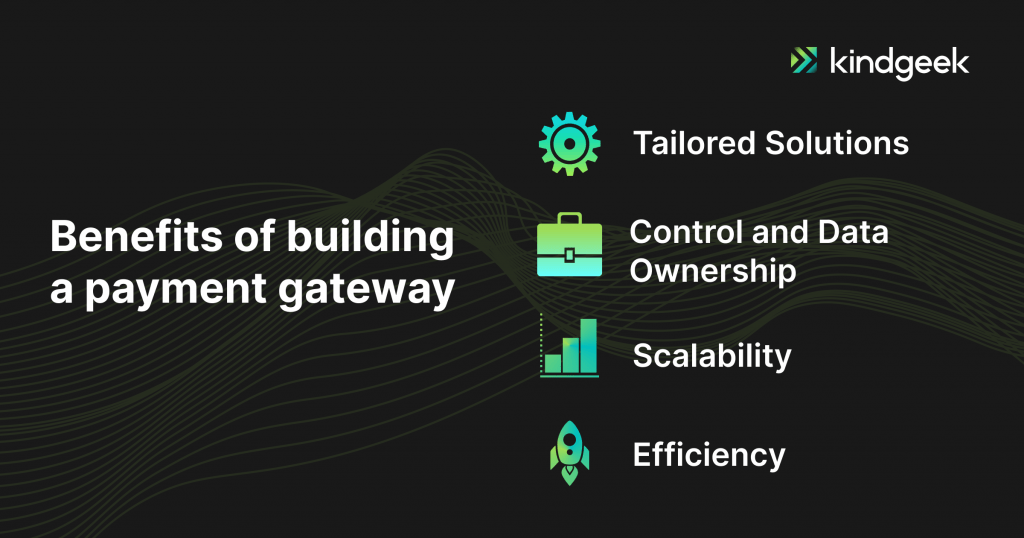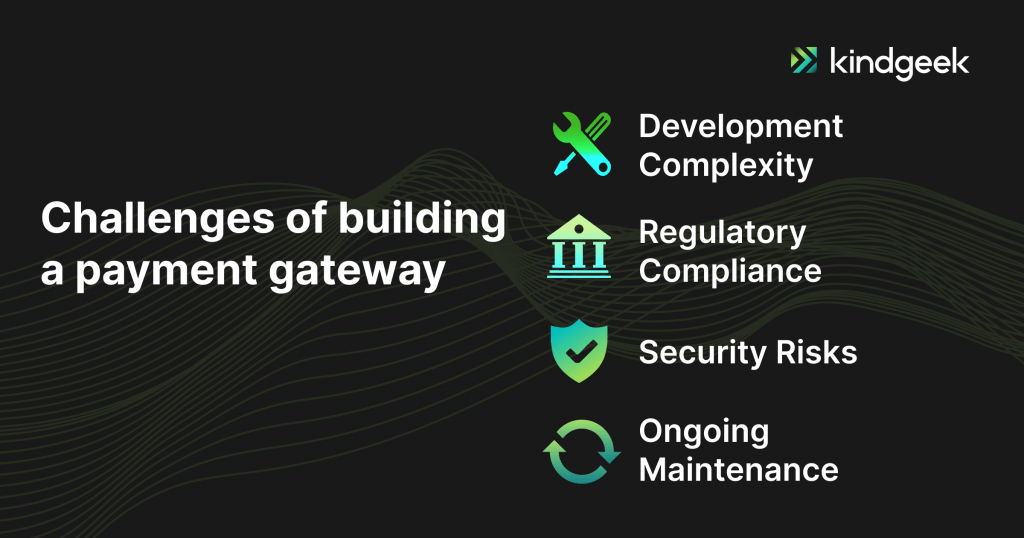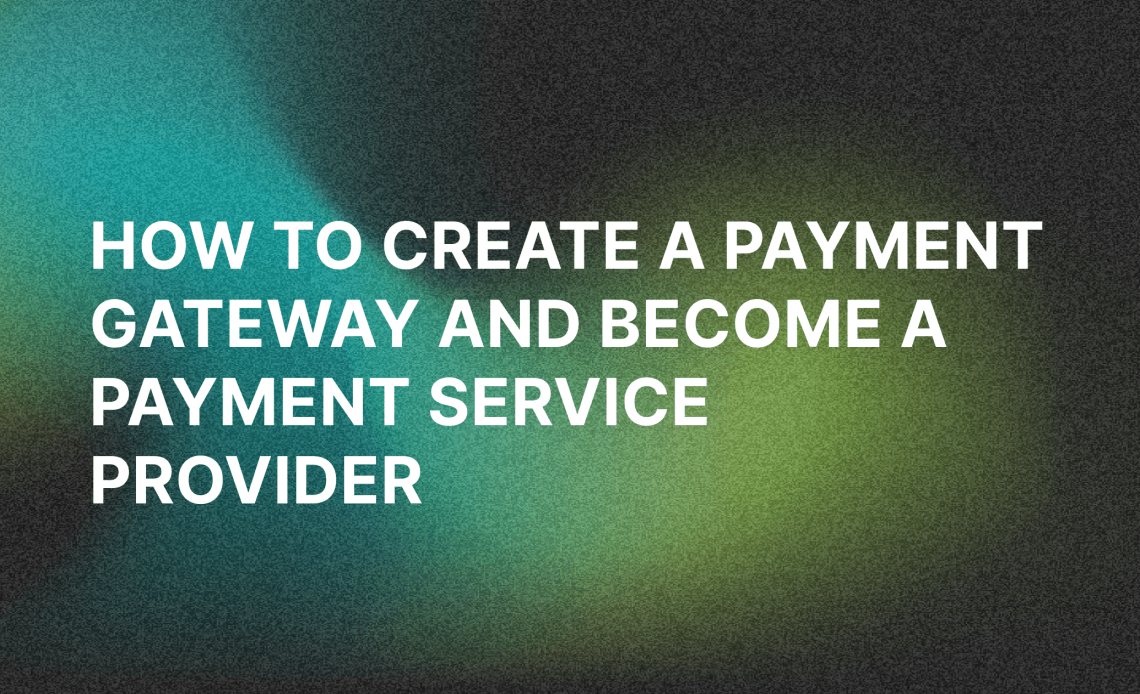Recently updated on April 18, 2024
Did you know that according to Statista, the total transaction value of digital payments will reach $15 trillion by 2027? In this ever-evolving landscape of online commerce, payment gateways play a pivotal role in shaping how businesses transact in the digital realm. They ensure secure, seamless payments, providing the trust and satisfaction of both customers and merchants. While many companies opt for established third-party solutions, a growing number seek to carve out their unique path by building custom payment gateways.
In this article, we’ll explore the world of payment gateways and give you a step-by-step guide to creating your own payment gateway and becoming a Payment Service Provider (PSP). From market research and regulatory compliance to the intricacies of development and fraud prevention, our guide equips you with the knowledge and tools necessary to navigate this dynamic landscape.
What is a payment gateway, and how does it work?
First, a payment gateway is a crucial component of the e-commerce ecosystem, serving as the intermediary between an online seller and the financial institutions that handle payment processing. It plays a pivotal role in facilitating secure and convenient online transactions.
It’s a technology-based service that enables online businesses to accept payments from their customers, usually through credit and debit cards, but also through other electronic payment methods like digital wallets and bank transfers. It acts as the virtual point-of-sale terminal, securely transmitting customer payment data to the acquiring bank or payment processor. It then authorizes the transaction and informs the merchant of the payment’s success or failure.
Let’s find out what is the role of a payment gateway system in payment processing:
Payment Data Encryption
Payment gateways encrypt sensitive customer information (like credit card details) to ensure data security during transmission. This encryption ensures that intruders cannot intercept the data.
Authorization
The gateway sends the payment details to the payment processor, which then communicates with the customer’s issuing bank to authorize or decline the transaction based on factors like available funds and fraud checks.
Secure Payment Processing
Once the authorization is granted, the payment gateway processes the transaction, deducting the amount from the customer’s account and transferring it to the merchant’s account.
Real-time Transaction Feedback
The gateway communicates with the e-commerce platform or the merchant to provide real-time feedback to both the seller and the customer regarding the payment status.
Fraud Detection
Many payment gateways come equipped with fraud detection and prevention tools that help identify and block suspicious transactions, protecting merchants and customers from fraud.
Payment Method Compatibility
Payment gateways often support various payment methods, including credit cards, debit cards, digital wallets (e.g., PayPal, Apple Pay), and even cryptocurrency, in some cases, making it easier for customers to pay using their preferred methods.
Settlement
After processing payments, the gateway helps settle the funds into the merchant’s bank account, usually within a specific time frame.
Who needs a custom payment gateway system?
A custom payment gateway system is typically required by businesses and organizations with specific needs or unique requirements that existing off-the-shelf payment gateway solutions cannot fully address. Here are some scenarios where a custom payment gateway system may be needed:
- Large businesses with high turnover seek complete control over how they will process payments and want to rely on something other than a third-party provider.
- Businesses with complex, highly specialized, or unique business models may require custom payment gateways. For example, crowdfunding platforms, subscription-based services with unique billing cycles, or marketplaces that need to split payments among multiple parties may opt for a custom solution.
- Businesses that are looking to become payment service providers.
- Businesses that deal with highly sensitive customer data or have unique security requirements may opt for custom gateways to implement specialized security measures.
- Banks, credit unions, and other financial institutions.
Main components of a payment gateway
Before building your own payment gateway, it is important to understand its main components:

Front-End Integration
This means the user-facing component of the payment gateway, which includes the checkout page or payment form where customers enter their payment information. Your payment gateway should be easy and intuitive for customers to conduct payments, ensuring it can handle their needs without them feeling any frustration.
Payment Processor
The payment processor connects the payment gateway to financial institutions, facilitating the authorization and settlement of transactions. It ensures the secure transfer of funds from the customer’s account to the merchant’s account. Integration to multiple payment processors offers several options for your merchants. With this, they can select the acquiring bank they want to use to create a settlement account.
Fraud Detection
Many payment gateways come with built-in fraud detection tools, which use algorithms and data analysis to identify and block potentially fraudulent transactions. Use advanced verification systems to authenticate users’ identities before they can use your gateway to make transactions.
Encryption and Security
This component ensures the security of sensitive payment data during transmission. It typically uses secure socket layer (SSL) or Transport Layer Security (TLS) protocols to encrypt data and protect it from unauthorized access.
Payment Methods Support
Payment gateways should support a variety of payment methods, including credit cards, debit cards, digital wallets (e.g., PayPal, Apple Pay), and bank transfers for maximum efficiency. You should also ensure that these payment methods can be processed seamlessly.
The backend interface
This is where you can manage payment settings, view transaction history, generate reports, and configure other aspects of payment processing.
Benefits and challenges of building a payment gateway
Developing a custom payment gateway system can be a significant investment in terms of time and resources. However, it offers the advantage of tailor-made solutions that align precisely with a business’s requirements and can provide a competitive edge. Businesses considering a custom payment gateway should carefully evaluate their needs and weigh the benefits against the costs involved in developing and maintaining a customized solution.
Let’s start with the benefits of building a payment gateway:

Tailored Solutions
A custom payment gateway can be designed to meet the specific needs and requirements of your business. It can align perfectly with your unique business model, industry, and customer expectations.
Control and Data Ownership
With a custom solution, you have more control over the payment process and can maintain ownership of sensitive payment data, which is essential for compliance and security.
Scalability
Custom gateways can be optimized for scalability, making them well-suited for businesses with high transaction volumes or those expecting rapid growth.
Efficiency
By streamlining the payment process and customizing it to your needs, a custom gateway can make transactions more efficient, reducing the likelihood of cart abandonment and increasing conversion rates.
While building your custom payment gateway brings a number of benefits, it’s also important to note that it comes with its own challenges and potential drawbacks, including:

Development Complexity
Developing a custom payment gateway is a complex and resource-intensive process. It requires expertise in payment processing, security, and compliance, and it can be time-consuming.
Regulatory Compliance
Custom gateways must adhere to industry-specific regulations and standards, such as PCI DSS for payment card security or GDPR for data protection. Ensuring compliance and maintaining it over time can be challenging.
Security Risks
Developing your payment gateway means taking on the responsibility of ensuring its security. Any vulnerabilities or breaches can have severe financial and reputational consequences.
Ongoing Maintenance
Once the custom gateway is in place, ongoing maintenance is required to keep it secure, updated, and compliant with changing regulations. This can be an ongoing cost and resource commitment.
7 Steps to create a payment gateway and become a payment service provider
Becoming a payment service provider (PSP) and creating a payment gateway involves several complex and regulated steps. This is a high-stakes industry, and it requires a deep understanding of payment processing, compliance, security, and financial operations. But if you decide to follow this path, let`s outline your steps:
Market Research and Business Planning
During this step, you will research the market to understand the demand for your payment services. You should also identify your target customer base, including the industries and businesses you plan to serve. Based on this research, you will develop a detailed business plan, including financial projections and a marketing strategy.
Regulatory Compliance and Registration
Understanding the regulatory landscape in your target market is essential for the industry. Different regions may have other regulatory requirements for PSPs and payment gateways. Identify the licenses and permits you need to operate legally in your target market. These include financial institution licenses or money transmitter licenses. During this stage, you must also investigate data security standards like PCI DSS to protect sensitive payment data. Implement robust security measures and protocols.
Business Relationships
Establish partnerships with acquiring banks and payment processors. You’ll need these relationships to process payments on behalf of your clients.
Development
This step should include different stages:
- Building or acquiring the technology infrastructure required to create your payment gateway. This includes server hosting, payment processing software, and databases.
- Developing APIs that allow merchants and e-commerce platforms to integrate with your payment gateway. Ensure compatibility with various payment methods and currencies.
- Creating a user-friendly front-end interface for customers to enter payment information. Integrate this interface with e-commerce websites and applications.
- Develop transaction authorization processes, including submitting payment requests to acquiring banks, customer verification, and settlement procedures.
Fraud Prevention and Risk Management
Implement robust fraud detection and prevention measures, such as machine learning algorithms and pattern recognition, to identify and block suspicious transactions. Establish risk management procedures to monitor and manage the risk associated with payment processing.
Testing and Quality Assurance
Thoroughly test your payment gateway to identify and resolve any issues or bugs. Perform real-world testing to ensure reliability and accuracy.
Ongoing Maintenance and Updates
Continuously maintain and update the payment gateway to address security vulnerabilities, regulatory changes, and emerging technologies.
Conclusions
Payment gateways are essential for e-commerce businesses, as they offer a secure, convenient, and efficient way to manage transactions, increasing customer trust and making it easier for companies to accept a wide range of payment methods. They also play a vital role in regulatory compliance, helping merchants meet security standards to protect customer data.
Creating a payment gateway and becoming a PSP is a complex and highly regulated process that involves substantial financial investments and legal responsibilities. It’s crucial to work with experts in the payments industry and stay informed about evolving regulations to ensure compliance and success in this competitive field.
If you are looking for a professional and trusted team to develop your custom fintech solution, consider Kindgeek. Since launch, we have provided core fintech banking and payment solutions as a software shortcut for businesses looking to launch their fintech products, from digital wallets to neobanks, accommodating startups and enterprise-level customers.




